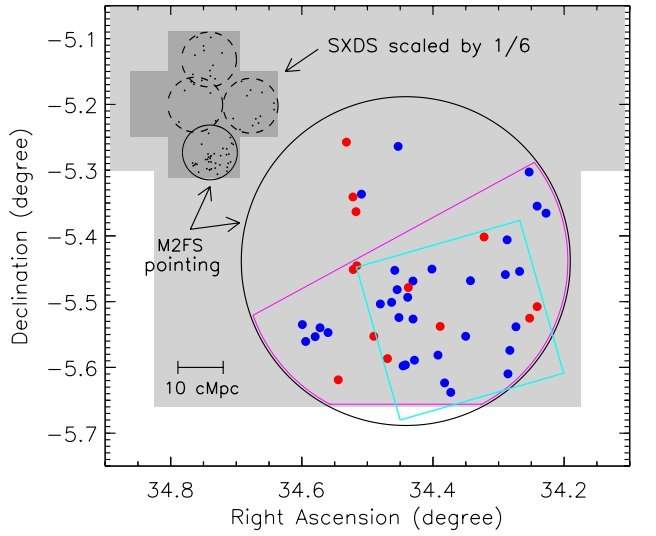October 25, 2018 report
New giant protocluster of galaxies discovered at high redshift

An international team of astronomers reports the discovery of a new giant protocluster of galaxies. The newly found protocluster was identified at a redshift of 5.7, when the universe was about 1 billion years old. The finding is detailed in a paper published October 15 on the arXiv pre-print server.
Galaxy clusters contain from hundreds to thousands of galaxies bound together by gravity. They are the largest known gravitationally bound structures in the universe, which could serve as excellent laboratories for studying galaxy evolution and cosmology.
Astronomers are especially interested in finding protoclusters of galaxies, the progenitors of clusters. Such objects, found at high redshifts, could provide essential information about the universe at its early stages. However, detecting these structures at high redshifts is challenging, requiring deep, wide-area surveys for proper identification.
Recently, a group of researchers led by Linhua Jiang of Peking University in Beijing, China, employed the M2FS fiber-fed, multi-object spectrograph mounted on the 6.5-m Magellan Clay telescope at Las Campanas Observatory in Chile to conduct a spectroscopic survey of galaxies in four square degrees of the sky. The observations were focused on identifying new luminous Lyman-alpha-emitting galaxies (Lyman-alpha emitters or LAEs) at redshifts between 5.7 and 6.5.
The study found dozens of LAE candidates and spotted an overdensity of such objects at a redshift of 5.7 in the XMM-Newton Deep Survey (SXDS) field. The research detected the existence of a giant protocluster in this overdense region, which received provisional designation SXDS_gPC.
"The combined SXDS images in five broad-band filters (BVRi'z') and two narrow-band filters (NB816 and NB921) have enabled us to efficiently select LAE candidates at z ≈ 5.7 and 6.5 via the Lyα technique. From these LAE candidates, we identified a large overdense region at z ≈ 5.7 in the SXDS. Here, we show that this overdense region contains a giant protocluster (SXDS_gPC for short) that will grow into a massive galaxy cluster," the paper reads.
According to the study, SXDS_gPC, which is expected to collapse into a giant galaxy cluster, occupies a volume of about 35 x 35 x 35 cubic co-moving megaparsecs and a present-day mass of approximately 3.6 quadrillion solar masses. This makes it one of the most massive clusters or protoclusters known to date.
The researchers emphasized that their discovery proves the existence of giant protoclusters at high redshifts. Hence, the finding contradicts the cold dark matter model predicting that small structures merge hierarchically to form large structures.
Morever, the astronomers noted that SXDS_gPC could also improve our understanding of the process of cosmic reionization, which ended at a redshift of about 6.0.
"The progenitor of SXDS_gPC is likely such a high-density region in the reionization era. Our results fit well into this scenario, and may provide direct evidence for the existence of large-scale clustering required by the above reionization theory," the researchers concluded.
More information: Linhua Jiang et al. A giant protocluster of galaxies at redshift 5.7, Nature Astronomy (2018). DOI: 10.1038/s41550-018-0587-9 , On Arxiv: arxiv.org/ftp/arxiv/papers/1810/1810.05765.pdf
Journal information: Nature Astronomy , arXiv
© 2018 Phys.org




















